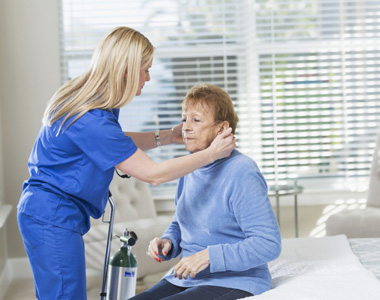
Over-the-counter (OTC) antihistamines are medicines that treat allergy symptoms. OTC means you can buy them at a store, without a doctor’s prescription. They are available as pills, liquids, nasal sprays, gels, and eyedrops.
There are two types of OTC antihistamines: first-generation and second-generation. Both can help allergies. First-generation antihistamines are sometimes used in OTC cold medicines.
Path to improved well being
When your body is exposed to allergens (allergy triggers), it makes histamines. Your body releases these chemicals to attack the allergen. Unfortunately, histamines cause the itching, sneezing, runny nose, and watery eyes associated with allergies. Antihistamines treat these symptoms.
First-generation OTC antihistamines
These were among the first antihistamines scientists developed. They are cheaper and widely available. They work in the part of the brain that controls nausea and vomiting. This means they can prevent motion sickness too. The most common side effects of first-generation antihistamines is feeling sleepy. For this reason, they are sometimes used to help people who have trouble sleeping (insomnia).
Some common kinds you can buy over the counter include:
- Brompheniramine (brand names include Children’s Dimetapp Cold)
- Chlorpheniramine (brand names include Chlor-Trimeton, Actifed Cold)
- Dimenhydrinate (brand names include Dramamine)
- Diphenhydramine (brand names include Benadryl, Nytol, Sominex)
- Doxylamine (brand names include Vicks NyQuil, Tylenol Cold and Cough Nighttime)
Second-generation OTC antihistamines
These are newer medicines. Many treat allergy symptoms without causing sleepiness. Common kinds include:
- Loratadine (brand names include Alavert, Claritin)
- Cetirizine (brand names include Zyrtec)
- Fexofenadine (brand names include Allegra)
Note: Some antihistamines are mixed with other medicines. These could include pain relievers or decongestants. Many of the brand names above are for these combination medicines. These are meant to treat many symptoms at the same time. It is a good idea to treat just the symptoms that you have. If you have only a runny nose, don’t choose a medicine that also treats headache and fever.
How do I safely take OTC antihistamines?
Read the directions on the label before taking any medicine. Learn how much to take and how often you should take it. If you have any questions about how much medicine to take, call your family doctor or pharmacist. Keep track of which OTC medicines you are using and when you take them. If you need to go to the doctor, take the list with you.
Follow these tips to make sure you are taking the right amount of medicine:
- Take only the amount recommended on the medicine’s label. Don’t assume that more medicine will work better or quicker. Taking more than the recommended amount can be dangerous.
- Mixing medicines can be dangerous. If you take a prescription medicine, ask your doctor if it’s okay to also take an OTC antihistamine.
- Don’t use more than 1 OTC antihistamine at a time unless your doctor says it’s okay. They may have similar active ingredients that add up to be too much medicine.
How can I safely store OTC antihistamines?
Store all medicines out of reach and sight of young children. Store in a cool, dry place so they do not lose effectiveness. Do not store them in bathrooms. These areas can get hot and humid.
Things to consider
Healthy adults don’t usually experience side effects from antihistamines. However, side effects can be a concern for older adults or people who have health problems. First-generation antihistamines may make you feel sleepy. This can affect your ability to drive or operate machines. They can make it hard to think clearly. Alcohol can increase the drowsiness caused by antihistamines. Antihistamines may cause your mouth and eyes to feel dry. They can also cause abdominal pain and headaches. Second-generation antihistamines are less likely to cause these side effects.
Could OTC antihistamines cause problems with any other medicines I take?
Antihistamines can interact with other medicines you take. Talk to your doctor before taking a first-generation antihistamine if you take any medicines that can make you tired. These include sleeping pills, sedatives, or muscle relaxants.
Antihistamines are often combined with decongestants and/or pain relievers. If you take a combination medicine, it’s important to know each active ingredient. One or more could interact with other medicines you’re taking.
Be sure not to take too much antihistamine. Many OTC cold and allergy medicines contain them already. Some prescription medicines do, too. If you take more than 1 of these medicines, you may get much more antihistamine than is good for you. Second-generation antihistamines are less likely to interact with other medicines you are taking. Always talk to your doctor if you take other medicines to make sure they are safe.
Who shouldn’t take antihistamines?
Talk to your doctor before using a first-generation antihistamine if you have any of the following health problems:
- Glaucoma.
- Trouble urinating (from an enlarged prostate gland).
- Breathing problems, such as asthma, emphysema, or chronic bronchitis.
- Thyroid disease.
- Heart disease.
- High blood pressure.
If you have kidney or liver disease, talk to your doctor before taking a second-generation antihistamine.
Questions to ask your doctor
- What kind of OCT antihistamine is the best one to treat my symptoms?
- What are the side effects?
- What is the maximum amount I should take a day?
- How long should I take the OTC antihistamine?
- My symptoms are not going away. Could I need something stronger?
- Are there any prescription-strength antihistamines? How do I know if I need one?











